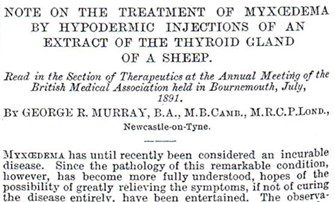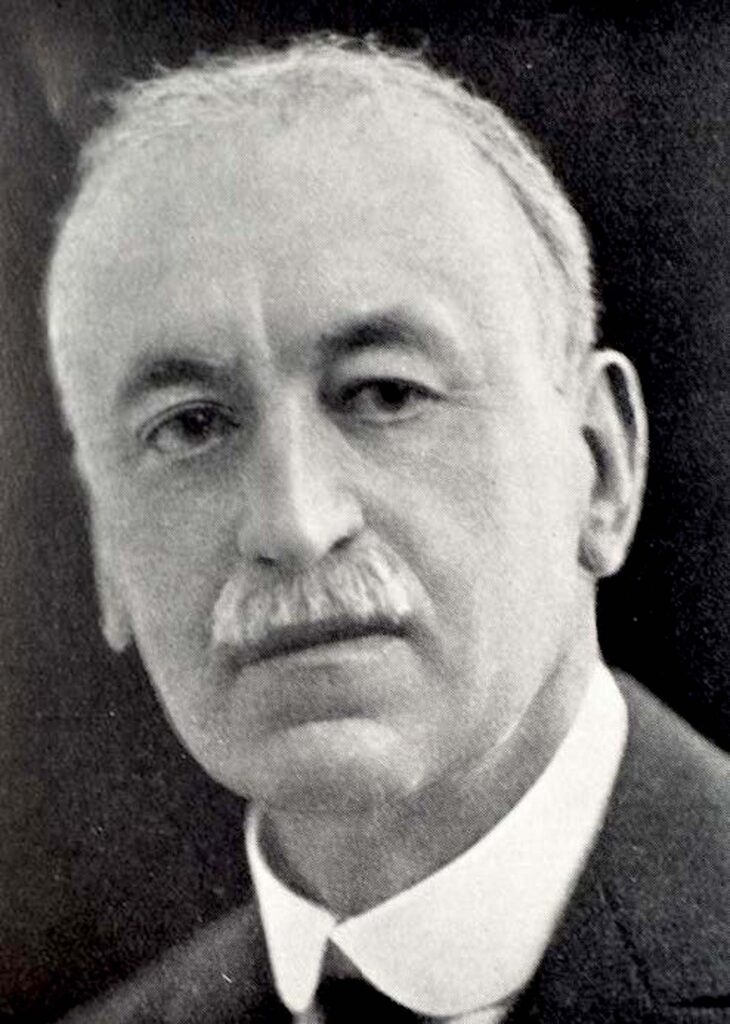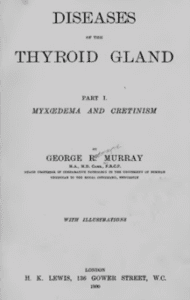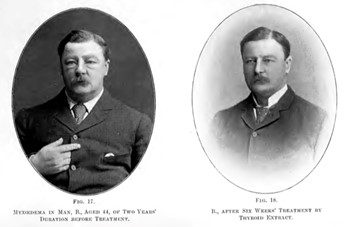JMS Pearce
Hull, England
 |
|
Fig 1. Note on treatment of myxedema. BMJ 2:796-797 via the James Lind Library. |
The transformation from myxedema to normal health is one of the most satisfying experiences for patient and physician that medicine has to offer. Yet until the end of the nineteenth century, the function of the thyroid gland was unknown. In the wake of Claude Bernard’s (1813–1878) term “internal secretion” in 1855 and his concept of the milieu interieur, Sir William Withey Gull in 1873 was one of the first to understand that atrophy of the thyroid gland was the cause of myxedema. Gull’s seminal paper related the changed appearance of a Miss B:
…after the cessation of the catamenial period, became insensibly more and more languid, with general increase of bulk…. Her face altering from oval to round…the tongue broad and thick, voice guttural, and the pronunciation as if the tongue were too large for the mouth (cretinoid)…. In the cretinoid condition in adults which I have seen, the thyroid was not enlarged. … There had been a distinct change in the mental state.1
 |
|
Fig 2. George R. Murray. James Lind Library. |
At a meeting of the Clinical Society of London in November 1883, the ENT surgeon Felix Semon drew attention to the cachexia strumipriva observed after thyroidectomy by Emil Theodor Kocher from Berne and Jaques-Louis Reverdin from Geneva. Semon proposed that myxedema, cachexia strumipriva, and cretinism were all owing to the same cause, namely absence or degeneration of the thyroid.2
William Ord reported an investigation for the Clinical Society of London in which Victor Horsley (1857–1916) had performed total thyroidectomy on monkeys and concluded that myxedema was almost certainly due to loss of thyroid function. Myxedema, he described as “mucous oedema, an excess of mucin” of the skin.3 In the same year, Moritz Schiff in Geneva and Theodor Kocher had successfully transplanted thyroid tissue into thyroidectomized dogs and humans.4
Until then, like Graves’ disease, hypothyroidism had been considered an affliction of the nervous system, which shows how little was known of the thyroid.
George Redmayne Murray (1865–1939) (Fig 2) of Newcastle, just three years after graduation, at a meeting of the Northumberland and Durham Medical Society on 12 February 1891, introduced the idea (Fig 1) of successful treatment of human myxedema by injections of sheep thyroid extract.5
Encouraged by his former teacher Victor Horsley, beginning on 13 April 1891 he injected a forty-six-year-old woman with myxedema with 1.5 mL of thyroid extract subcutaneously, twice weekly. After three months his patient was dramatically improved. She lived till the age of seventy-four.
In his first BMJ paper, Murray provided his rationale for treatment (Fig 3):
!["If we consider that myxœdema amd cachexia strumipriva are due to the absence from the body of the some substance which is present in the normal thyroid gland, and which is necessary to maintain the body in health, it is at least rational treatment to supply that deficiency as far as possible by injecting the extract of a health gland. G. Vessale[1] has made intravenous injections of an extract of the thyroid gland in dogs after thyroidectomy with beneficial results. As far as I am aware this means of treatment has not before been tried in the human subject. Since suggesting this treatment at the February meeting of the Northumberland and Durham Medical Society, I have been able to carry it out in a well-marked case of myxœdema. Such decided improvement has resulted that the details of the method of treatment employed and the results obtained are worth recording. After"](https://b1480254.smushcdn.com/1480254/wp-content/uploads/2023/03/murray-rationale-for-myxedema-treatment-e1677710863324.jpg?lossy=1&strip=1&webp=1) |
| Fig 3. Murray’s rationale for treatment. |
 |
|
Fig 4. Murray’s Diseases of the Thyroid Gland (1900). |
He acknowledged the brief report in June 1890 by Bettencourt and Serrano of Lisbon,6 who had inserted half of a sheep’s thyroid subcutaneously into one of their hypothyroid patients with marked improvement after one month, though this was sometimes short-lived.7
In his Diseases of the Thyroid Gland (Fig 4), Murray gave a long and scholarly account of myxedema—primary and secondary—and of cretinism.8
He noted the experiments of Schiff and von Eiselsberg, which showed that a portion of thyroid gland successfully transplanted into the subcutaneous tissues of a dog or cat was able to maintain a sufficient supply of secretion after removal of the animal’s thyroid gland to avert the usual acute symptoms of “athyroidism.” Victor Horsley suggested that a similar procedure should be adopted in patients to arrest the inevitable progress of myxedema to a fatal termination.
Murray therefore prepared a glycerin extract (liquor thyroidei) from the healthy thyroid gland of sheep given subcutaneously. This method was used at first both in humans and in male bonnet monkeys. He concluded:
The symptoms of primary and secondary myxredema in man can be entirely removed by the internal administration of thyroid secretion obtained from one of the lower animals, and do not return as long as the supply of the secretion is adequately maintained.
He advised initially small doses of three to five minims [0.29 mL] of liquor thyroidei given each night, slowly increasing to ten minims or two grains [130 mg] of dry thyroid. He prudently advised “great caution, especially if any symptoms of degeneration of the cardiac muscle, such as attacks of syncope, dyspnoea on exertion, feeble or irregular pulse, or weak heart sounds are present.”
 |
|
Fig 5. Murray’s patient before and after thyroid treatment. |
He described the subsequent improvement in all symptoms: fatigue, slowness, facial appearance (Fig 5), weight, and temperature over several weeks or months.
After Murray’s paper, large numbers of patients were treated, the details and precautions quickly established.9 Murray and others later routinely used Fox’s dried thyroid extract grains 2–3, in preference to the cruder liquor. Brady & Martin Chemists, Northumberland Road, made the thyroid extracts. Thyroxin was isolated by EC Kendall on Christmas Day 1914, synthesized in 1927, and became available from Glaxo in 1949. Tablets of dried thyroid extract, however, remained the principal treatment until replaced by synthetic thyroxin in the 1960s.10
Many years later, Deborah Doniach and Ivan Roitt discovered thyroglobulin autoantibodies in Hashimoto’s thyroiditis,11 which paved the way for its treatment12 and the subsequent identification of other organ-specific autoimmune diseases.
George Redmayne Murray
George Murray was born in Newcastle upon Tyne, son of William Murray MD FRCP. He enjoyed a privileged education at Eton and Trinity College Cambridge, being placed in the first class of the natural sciences tripos of 1886. He qualified in medicine from University College London in 1888, receiving the Fellowes gold medal in the same year. He proceeded MD in 1896 and was elected FRCP in 1893. After training in Berlin and Paris he was appointed Heath Professor of Comparative Pathology at Durham University in 1893, and physician to the Royal Victoria Infirmary in his native Newcastle in 1898. Ten years later, he was invited to become professor of systematic medicine at Manchester University and physician to the Manchester Royal Infirmary.
He was a member of the Medical Research Council, and at the Royal College of Physicians gave the Goulstonian lecture in 1899 and the Bradshaw lecture in 1905. He also described how pure carbolic acid could be used to quickly and satisfactorily sterilize hypodermic syringes. He wrote essays on exophthalmic goiter, endocrinology,13 and monographs on Diseases of the thyroid gland (1900), Thyroid secretion as a factor in exophthalmic goiter (1893), and On the pathology of exophthalmic goiter (1896).
Murray married Annie, daughter of ER Bickersteth, FRCS. He died at his home in Mobberley, Cheshire on 21 September 1939, survived by his wife, son, and daughter.
A blue plaque at Saville Place (Fig 6) in Newcastle commemorates him.
In Murray’s time, hormones had not been discovered. Murray made a remarkable medical advance, one from which millions of people benefit. In May 2016, doctors and researchers from around the world attended a conference hosted by Newcastle University and the British Thyroid Association to mark 125 years since the discovery of thyroid hormone replacement.
References
- Gull WW. On a cretinoid state supervening in adult life in women. Transactions of the Clinical Society of London, 1873-1874, 7: 180-185.
- Semon F. In discussion of “A typical case of myxoedema” by FD Drewitt in the Proceedings of the Clinical Society of London. British Medical Journal 1883;2:1072-4.
- Ord WM. Report of a committee of Clinical Society of London nominated December 14, 1883, to investigate the subject of myxoedema. Trans Clin Soc Lond 1888; 21, supplement.
- Tröhler U. Towards endocrinology: Theodor Kocher’s 1883 account of the unexpected effects of total ablation of the thyroid. James Lind Library 2010. jameslindlibrary.org.
- Murray GR. Note on the treatment of myxoedema by hypodermic injections of an extract of the thyroid gland of a sheep. British Medical Journal 1891;2:796-7.
- Bettencourt R, Serrano JA. Un cas de myxoedème traité par la greffe hypodermique du corps thyroïde d’un mouton. La Semaine Médicale 1890;10:294.
- Sawin CT. The invention of thyroid therapy in the late nineteenth century. The Endocrinologist 2001;11:1-3.
- Murray GR. Diseases of the thyroid gland. London HK Lewis 1900.
- Bramwell B. The thyroid treatment of myxoedema and sporadic cretinism, with notes of twenty-three cases of myxoedema and five cases of sporadic cretinism, treated by thyroid extract. Edinburgh Hosp Rep 1895;3:116-249.
- Slater SD (2010). The discovery of thyroid replacement therapy. James Lind Library Bulletin: Commentaries on the history of treatment evaluation. jameslindlibrary.org/articles/the-discovery-of-thyroid-replacement-therapy/.
- Weetman A. Autoimmune thyroiditis: predisposition and pathogenesis. Clin Endocrinol 1992;36:307-23.
- Pearce SHS, Brabant G, Duntas LH, et al. 2013 ETA Guideline: management of subclinical hypothyroidism. Eur Thyroid J 2013; 2: 215-28.
- Murray GR. The diagnosis and treatment of some diseases of the endocrine glands. British Medical Journal 1920;2: 807-11.
JMS PEARCE is a retired neurologist and author with a particular interest in the history of medicine and science.
Winter 2023 | Sections | History Essays

Leave a Reply